Centauri Dreams
Imagining and Planning Interstellar Exploration
Interstellar Probe: Pushing Beyond Voyager
Our doughty Voyager 1 and 2, their operations enabled by radioisotope power systems that convert heat produced by the decay of plutonium-238 into electricity, have been pushing outward through and beyond the Solar System since 1977. Designed for a four and a half year mission, we now have, more or less by accident and good fortune, our first active probes of nearby interstellar space. But not for long. At some point before the end of this decade, both craft will lack the power to keep any of their scientific instruments functioning, and one great chapter in exploration will close.
What will the successor to the Voyagers look like? The Johns Hopkins University Applied Physics Laboratory (JHU/APL) has been working on a probe of the local interstellar medium. We’re talking about a robotic venture that would be humanity’s first dedicated mission to push into regions that future, longer-range interstellar craft will have to cross as they move far beyond the Sun. If it flies, Interstellar Probe would be our first mission designed from the start to be an interstellar craft.
Pontus Brandt is an Interstellar Probe Concept Study project scientist, in addition to being principal investigator for two instruments aboard the European Space Agency’s Jupiter Icy Moon Explorer (JUICE) Mission. Brandt puts the ongoing work in context in a recent email:
Interstellar Probe would represent Humanity’s first deliberate step into interstellar space and go farther and faster than any spacecraft before. By using conventional propulsion, Interstellar Probe would travel through the boundaries of the protective heliosphere into the unknown interstellar cloud for the first time. Within its lifetime, it would push far beyond the Voyager mission to explore the heliospheric boundary and interstellar space so that we can ultimately understand where our home came from, and where we are going.
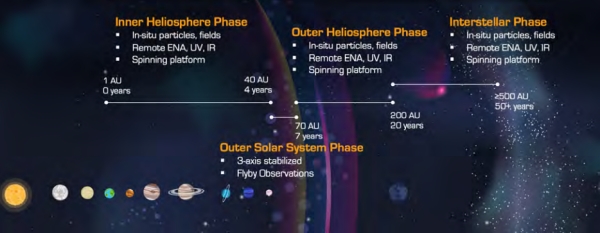
Image: A possible operation scenario, divided into phases and indicating science goals along the way. Credit: JHU/APL, from the Interstellar Probe 2019 Report.
The nature of the interstellar cloud Brandt refers to is significant. But before examining it, a bit of background. APL’s role in Interstellar Probe has roots in principal investigator Ralph McNutt’s tireless advocacy of what was once called Innovative Interstellar Explorer, a report originally funded by NASA in 2003 and often discussed in these pages. The current study began in 2018 and will continue through early 2022, examining the technologies that would make Interstellar Probe possible, with an eye on the coming Decadal Survey within NASA’s Heliophysics Science Division. Bear in mind as well that the space community has been discussing what we can call ‘interstellar precursor’ missions all the way back to the 1960s — an interesting story in itself! — and the Interstellar Probe concept appeared in the 2003 and 2013 Heliophysics Decadal Surveys.
About those Decadals: Every ten years, Decadal Surveys appear for the four NASA science mission divisions: Planetary Science, Astrophysics, Heliophysics and Earth Science, the idea being to provide guidance for the agency’s science program going forward. So the immediate context of the current effort at APL is that it is being conducted to provide technical input that can feed into the next Heliophysics Decadal Survey, which will cover the years 2023 to 2032. But the implications for science across all four divisions are part of APL’s remit, affecting specific targets and payloads.
What can realistically be done within the 2023-2032 time frame? And what kind of science could a mission like this, launching perhaps in 2030, hope to accomplish? Workshops began in June of 2018 and continue to refine science goals and support engineering trade studies in support of what the team calls “a ‘pragmatic’ interstellar probe mission.” The most recent of these, the fourth, just concluded on October 1. You can see its agenda here.
A launch in the early 2030s demands not futuristic technologies now in their infancy but proven methods that can be pushed hard in new directions. This is, you might say, ‘Voyager Plus’ rather than the starship Enterprise, but you build interstellar capability incrementally absent unexpected breakthroughs. That calls for a certain brute force determination to keep pushing boundaries, something Ralph McNutt and team have been doing at APL, to their great credit , for many years now. A spacecraft like this would be a flagship mission (now known as a Large Strategic Science Mission) — these are the most ambitious missions the agency will fly, a class that has included the Voyagers themselves, Cassini, Hubble and the James Webb Space Telescope.
A variety of methods for reaching beyond the heliosphere in the shortest possible time have been under consideration, including an “Oberth maneuver” (named after scientist Hermann Oberth, who documented it in 1929), where a propulsive burn is performed during a close solar pass that has itself been enabled by a retrograde Jupiter gravity assist. Other Jupiter flyby options, with or without a propulsive burn via a possible upper stage, remain on the table. The plan is to drive the probe out of the Solar System at speeds sufficient to reach the heliopause in 15 years. The participating scientists talk in terms of a flyout speed of 20 AU/year, which translates to 95 kilometers per second. Voyager 1, by comparison, is currently moving at roughly 17.1 kilometers per second.
The Voyagers own our current distance records, with Voyager 1 currently at 154 AU and Voyager 2 at 128 AU. Interstellar Probe would still be returning science at 1000 AU, meaning it would be capable of looking back and seeing not just the Earth in the context of the Solar System, as in Voyager’s ‘pale blue dot’ image, but also taking measurements of the heliosphere from well outside it, helping us understand both the interstellar medium and the effect of our stellar system as it moves through it.
There is much to be learned about the protective magnetic bubble called the heliosphere in which the entire Solar System is embedded. We have to understand that it is anything but static, as Pontus Brandt explains:
During its evolutionary journey around the galaxy, [the Sun] has plowed through widely different environments, witnessed supernova explosions on its path, that have all shaped the system that we live in today. The vast differences in interstellar densities, speeds, charge fractions have been responsible for an extreme range of sizes and shapes of the global heliosphere throughout its history – from many times bigger than today, to a tiny heliosphere below even the orbit of Earth. This, in turn, has had dramatic consequences for the penetration of the primordial soup of interstellar material that have affected several crucial aspects of elemental and isotopic abundances, atmospheric evolution, conditions for habitability and perhaps even biological evolution. Only some 60, 000 years ago, the Sun entered the vast Local Interstellar Cloud (some 30 light years across), and in just a few thousand years the solar system will enter a completely different interstellar cloud that will continue to shape its evolution.
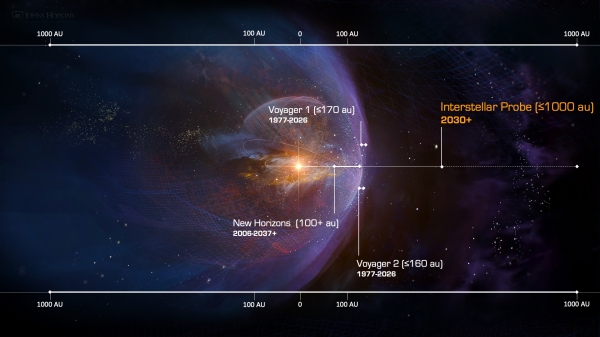
Image: The Sun is on the way to exiting the Local Interstellar Cloud and entering another unexplored interstellar region. Credit: NASA/Goddard/Adler/U. Chicago/Wesleyan.
An interstellar precursor mission can examine energetic neutral atoms (ENAs) to provide data on the overall shape of the heliosphere. Major issues include how plasma from the Sun’s solar wind interacts with interstellar dust to form and continue to shape the heliosphere.
But a mission like this also shapes our views of time, as the Voyagers have done as we have watched their progress through the Solar System, the heliosphere and beyond. Mission scientists turned the 4.5 year mission into a surprising 45 year one solely on the strength of their design and the quality of their components, not to mention the unflagging efforts of the team that operates them. A mission designed from the start for 50 years, as Interstellar Probe would be, will likely have a lifetime far beyond that. Its components are meant to be functional when our grandchildren are in their dotage. Most of its controllers in 2080 have yet to be born.
So this is a multi-generational challenge, a reach beyond individual lifetimes. Let me quote from the Interstellar Probe Study 2019 Report, which is now available online.
It is important to note that the study does not purport to center on “the one and only” interstellar probe but rather on this mission as a first step to more advanced missions and capabilities… In addition to promising historically groundbreaking discoveries, the Interstellar Probe necessitates a transformation in the programmatics needed to accommodate lifetime, reliability, and funding requirements for this new type of multigenerational, multi-decade operational mission. Paving the way for longer journeys utilizing future propulsion technologies, such as those not invoked here, the Interstellar Probe is the first explicit step we take today on the much longer path to the stars.
Principal investigator Ralph McNutt tells me that the Interstellar Probe team is finishing up a Mission Concept Report for NASA on the progress thus far, incorporating results of the recent workshop. This report should be available on the Interstellar Probe website in early December, with a number of items clarifying aspects of the currently available 2019 report. We need to dig into some of the issues that will appear there, for the concept is changing as new studies emerge. In particular, let’s look next time at the ‘Oberth maneuver’ idea, what it means, and whether it is in fact a practical option. I’m surprised at what’s emerging on this.

The Survival of M-Dwarf Planet Atmospheres
I was interested in yesterday’s story about the two super-Earths around nearby M-dwarfs — TOI-1634b and TOI-1685b — partly because of the research that follows. In both cases there is the question of atmospheres. The two TESS planets are so numbingly close to their host stars that they may have lost their original hydrogen/helium atmospheres in favor of an atmosphere sustained by emissions from within. Hearteningly, we should be able to find out more with the James Webb Space Telescope, on which ride the hopes of so many exoplanet researchers.
Today’s system is the intriguing L 98-59, only 35 light years from Earth and possessed of at least four planets, with a fifth as yet unconfirmed. Here we have two rocky inner worlds, a possible ocean planet (L 98-59 d) and another likely rocky world to the inside of the habitable zone boundary. Perhaps within the habitable zone, if it exists, is L 98-59f, so this is a system to keep an eye on, an obvious candidate as a JWST target.
At UC Riverside, Daria Pidhorodetska wants to know whether small, rocky planets orbiting M-dwarfs like this one have atmospheres. The paper is devoted to the question of whether either Hubble or JWST, perhaps working in tandem, could detect atmospheres in this system. The authors proceeded to model four different types of atmospheres to answer the question with regard to the three inner planets.
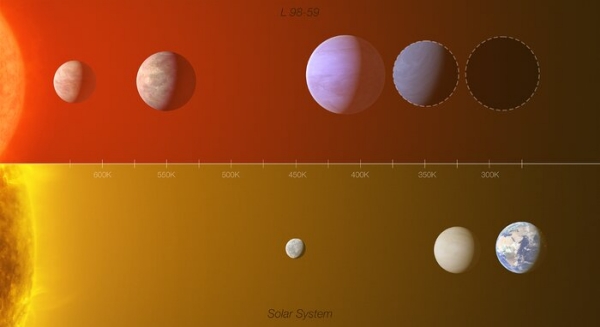
Image: This is an infographic from the European Southern Observatory showing a comparison between the L 98-59 exoplanet system (top) with part of the inner Solar System (Mercury, Venus and Earth), highlighting the similarities between the two. L 98-59 contains four confirmed rocky planets (marked in color in the top panel), orbiting a red-dwarf star 35 light-years away. The planet closest to the star is around half the mass of Venus, making it the lightest exoplanet ever detected using the radial velocity technique. Up to 30% of the third planet’s mass could be water, making it an ocean world. The existence of the fourth planet has been confirmed, but scientists don’t yet know its mass and radius (its possible size is indicated by a dotted line). The team also found hints of a potential fifth planet, the furthest from the star, though the team knows little about it. If confirmed, it would sit in the system’s habitable zone where liquid water could exist on its surface. Credit: ESO/L. Calçada/M. Kornmesser (Acknowledgment: O. Demangeon). [Note: The distances from the stars and between the planets in the infographic are not to scale. The diagram has been scaled to make the habitable zone in both the Solar System and in L 98-59 coincide].
A major problem for M-dwarf planets, to go along with tidal lock, is the fact that during their formation, they are bathed in intense ultraviolet radiation. Enough so that the potential is there to cause any water at the surface to evaporate, while their atmospheres would be under a fierce barrage and might not survive. The question for Pidhorodetska and team is, then, whether the two inner rocky planets have lost their atmospheres completely, if they had one, or if they have been able to replenish them.
The range of atmospheric scenarios takes in planets with atmospheres dominated by water, hydrogen, carbon dioxide, or oxygen and ozone (remaining after loss of hydrogen). The authors argue that an oxygen-dominated atmosphere is the most likely. For each of these scenarios, the authors simulated transmission spectroscopy. L 98-59’s proximity to Earth as well as the fast orbits (less than a week) of its planets speeds up the process of discovery. In fact, says Edward Schwieterman (UC Riverside):
“It would only take a few transits with Hubble to detect or rule out a hydrogen- or steam-dominated atmosphere without clouds. With as few as 20 transits, Webb would allow us to characterize gases in heavy carbon dioxide or oxygen-dominated atmospheres.”
I’m interested, though, specifically in that question of atmosphere loss, with hydrogen escape leaving oxygen and ozone behind. The paper explains:
Highly irradiated planets such as those of the L 98-59 system could have a desiccated atmospheric composition, such as one that is dominated by O2, as a result of major ocean loss during an extended runaway greenhouse phase. A desiccated planet that is rich in abiotic O2 would be expected to form O3 from the photochemical processing of O2, meaning that the direct detection of O3 absorption could be another key indicator of this planetary state.
And the authors point out in their conclusion that we can learn a great deal about the evolution of these planets depending on whether we detect water in their atmospheres. An atmosphere high in oxygen due to the loss of hydrogen during the star’s pre-main sequence phase — in other words, an atmosphere that survives utter desiccation — should have no oceans to detect. Water, or the lack of it, is another marker for this early stage of planetary evolution, and our instruments should be able to make the call.
The paper is Pidhorodetska et al., “L 98-59: A Benchmark System of Small Planets for Future Atmospheric Characterization,” Astronomical Journal Vol. 162, No. 4 (29 September 2021), 169 (full text).

Atmospheric Evolution on Hot Super-Earths
Hot Jupiters (notice I’ve finally stopped putting the term into quotation marks) were the obvious early planets to detect, even if no one had any idea whether such things existed. I suppose you could say Greg Matloff knew, at least to the point that he helped Buzz Aldrin and John Barnes come up with a plot scenario involving a planet that fit the description in their novel Encounter with Tiber (Grand Central, 1996), which was getting published just as the hot Jupiter 51 Pegasi b was being discovered. Otto Struve evidently predicted the existence of gas giants close to their star as far back as 1952, but it’s certainly true that planets like this weren’t in the mainstream of astronomical thinking when 51 Pegasi b popped up.
Selection effect works wonders, and it makes sense that radial velocity methods would bear first fruit with a large planet working its gravitational effects on the star it orbits closely. Today, using transits, gravitational microlensing, astrometry and even direct imaging, we’re uncovering a much more representative sample of what’s out there, and hot Jupiters are somewhere around 1 percent of the catalog. Similarly rare, I’m sure, are the planets classed as ultra-short period worlds (USP), though they’re much smaller, with radii in the range of 2 Earth radii and periods of less than a day. We now have evidence for somewhere around 100 of these planets.
Two recently discovered examples are the planet candidates TOI-1634b and TOI-1685b, both of them TESS catches and subsequently examined by the Subaru Telescope (Mauna Kea, Hawai?i), supplemented with data from other observatories. An international team of astronomers have been at work on this duo, led by Teruyuki Hirano (University for Advanced Studies, Tokyo). The planet candidates are in Perseus, the first about 114 light years away; the second is 122 light years out. Both have now been confirmed to be rocky super-Earths (and I’m no longer going to put that term in quotation marks either). Both are likewise USPs, with ultra-tight orbits of less than 24 hours.
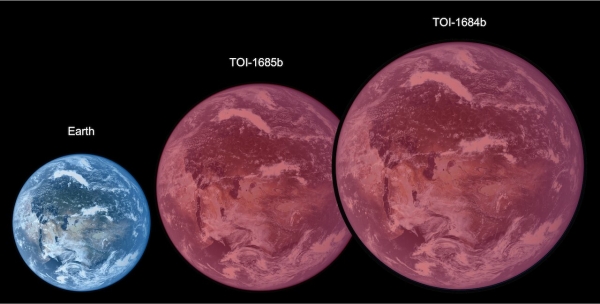
Image: Artist’s conceptual image showing the sizes of the planets observed in this study. The radius of TOI-1634b is 1.5 times larger than Earth’s radius and TOI-1685b is 1.8 times larger [note: the planets are mislabeled in the image]. The planets would appear red, due to the light from the red dwarf stars they orbit. Credit: Astrobiology Center.
As you’ll note from the caption above, the Subaru work (using the InfraRed Doppler — IRD — spectrograph mounted on the telescope) has been able to measure the masses of these transiting worlds. Here the chief interest is the fact that both lack a primordial hydrogen-helium atmosphere, which may or may not be the result of their proximity to their host stars.
Are there secondary atmospheres here, made up of gases released from within the planets? It’s an interesting speculation, as examining their constituents would tell us a lot about how these planets formed. The origins of USPs have been discussed in the literature in terms of inward migration, their highly circularized orbits the result of tidal interactions. There has been some suggestion that they represent remnant cores from hot Jupiters whose atmospheres have dissipated, but their hosts stars have different metallicity values than hot Jupiter host stars.
TOI-1634b and TOI-1685b, both of them orbiting M-dwarfs and relatively close to the Earth, may help us move forward in probing these issues, because to date there are few well characterized planets in the USP category; in fact, only the red dwarfs LTT 3780 and GJ 1252 have USP planets whose masses have been precisely measured. The authors note that TESS has been deeply involved in the hunt for more USPs, with 151 candidates announced as of February of 2021. 31 of these are known to orbit M-dwarfs.
The authors drew data from instrumentation ranging from Subaru itself to the MuSCAT imager at the Okayama Astro-Complex in Japan, the TCS telescope at Teide Observatory in Spain, the Gemini North telescope and Keck Observatory on Mauna Kea. Thus we’re examining data from ground-based transit photometry to high-resolution imaging, reconnaissance spectroscopy and radial velocity measurements, refining the orbital periods of these planets by more than an order of magnitude. Their future utility in atmospheric studies is clear. From the paper:
TOI-1634b is one of the largest and most massive USP planets having an Earth-like composition, and therefore, would become a benchmark target to study the formation and evolution history of massive USP planets. Both planets are listed among the best suitable targets for future atmospheric studies of small rocky planets by emission spectroscopy thanks to the brightness of the host stars, which encourages future characterizations using large aperture telescopes including JWST. Although small USP planets (< 2 R?) are likely to have lost the primordial atmospheres dominated by H2 and He, one may be able to probe and constrain the secondary atmosphere formed via the outgassing from the planet interior.
The paper is Hirano et al, “Two Bright M Dwarfs Hosting Ultra-Short-Period Super-Earths with Earth-like Compositions,” The Astronomical Journal Vol. 162, No. 4 (23 September, 2021). Abstract / Preprint.

Hit-and-Run: Earth, Venus and Planet-Shaping Impacts
The gradual accretion of material within a protoplanetary disk should, in conventional models, allow us to go all the way from dust grains to planetesimals to planets. But a new way of examining the latter parts of this process has emerged at the University of Arizona Lunar and Planetary Laboratory in Tucson. There, in a research effort led by Erik Asphaug, a revised model of planetary accretion has been developed that looks at collisions between large objects and distinguishes between ‘hit-and-run’ events and accretionary mergers.
The issue is germane not just for planet formation, but also for the appearance of our Moon, which the researchers treat in a separate paper to extend the model for early Earth and Venus interactions that appears in the first. In the Earth/Venus analysis, an impact might be a glancing blow that, given the gravitational well produced by the Sun, could cause a surviving large part of an Earth-impactor (the authors call this a ‘runner’) to move inward and subsequently collide with Venus. So we’re not talking about impacts alone, but about impact ‘chains.’ The implications of this multi-impact theory on planet composition may be profound.
Alexandre Emsenhuber (now at Ludwig Maximilian University, Munich) is lead author of the paper on Earth/Venus interactions, pointing to the different impact scenarios for Earth and Venus:
“The prevailing idea has been that it doesn’t really matter if planets collide and don’t merge right away, because they are going to run into each other again at some point and merge then. But that is not what we find. We find they end up more frequently becoming part of Venus, instead of returning back to Earth. It’s easier to go from Earth to Venus than the other way around.”

Image: The terrestrial planets of the inner solar system, shown to scale. According to ‘late stage accretion’ theory, Mars and Mercury (front left and right) are what’s left of an original population of colliding embryos, and Venus and Earth grew in a series of giant impacts. New research focuses on the preponderance of hit-and-run collisions in giant impacts, and shows that proto-Earth would have served as a ‘vanguard’, slowing down planet-sized bodies in hit-and-runs. But it is proto-Venus, more often than not, that ultimately accretes them, meaning it was easier for Venus to acquire bodies from the outer solar system. Credit: Lsmpascal – Wikimedia Commons.
This work draws on a 2019 analysis by the same authors that first examined hit-and-run collisions and subsequent mergers of the two bodies. The authors point out that most simulations of this stage of planetary evolution assume perfect mergers for all impacts that are not completely catastrophic. Reflecting on this, they write:
Emsenhuber & Asphaug (2019a, hereafter Paper I) showed that this is not generally the case. They studied the fate of the runner following hit-and-runs into proto-Earths at 1 au, for thousands of geometries, and found that, contrary to expectation, only about half the time (depending on the runner’s egress velocity, which depends on the impact velocity and angle) do they return to collide again with proto-Earth. When they do, the return collision happens on a timescale of thousands to millions of years.
That work — fully treated in the first of the papers cited below — also revealed that the majority of the runners that did not return to the forming Earth would be likely to collide with Venus, given the assumption of their current masses and orbits. Those runners that did return would show an impact velocity in the second collision similar to the egress velocity after the first hit and run, thus slower than the original impact because of momentum loss. Follow-on collisions, then, are likely to be slow.
So we have a scenario in which the Earth takes repeated hits and spins off many impactors toward the inner system as they fall deeper into the Sun’s gravity well rather than eventually assimilating them itself. It’s an interesting notion given that, while Earth and Venus (so-called ‘sister planets’) have similar mass and density, Venus is nonetheless in a distinctly different state, its rotation retrograde compared to other planets, with a single rotation taking 243 days. There are also no moons at Venus. Do impacts during formation account for the differences?
To put the thesis to the test, the scientists built predictive models from 3D simulations of such impacts, drawing on machine learning techniques. They simulated terrestrial planet evolution over the course of 100 million years, calculating both hit-and-run collisions and those in which the impactor merged with the object struck.
The simulations explore the dynamical evolutions of remnants of hit-and-run collisions until the impactor is finally accreted or ejected.The different scenarios, says Asphaug, portray a sharply different formation history for the two worlds:
“In our view, Earth would have accreted most of its material from collisions that were head-on hits, or else slower than those experienced by Venus. Collisions into the Earth that were more oblique and higher velocity would have preferentially ended up on Venus…. We find that most giant impacts, even relatively ‘slow’ ones, are hit-and-runs. This means that for two planets to merge, you usually first have to slow them down in a hit-and-run collision. To think of giant impacts, for instance the formation of the moon, as a singular event is probably wrong. More likely it took two collisions in a row.”
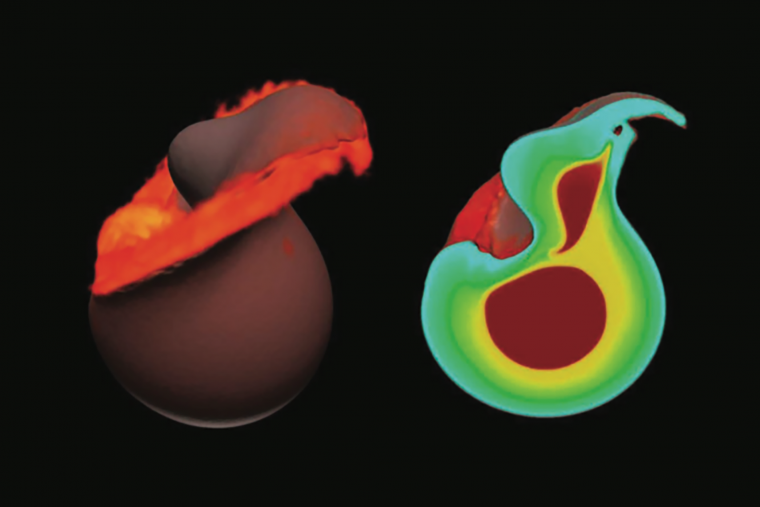
Image: The Moon is thought to be the aftermath of a giant impact. According to a new theory, there were two giant impacts in a row, separated by about 1 million years, involving a Mars-sized ‘Theia’ and proto-Earth. In this image, the proposed hit-and-run collision is simulated in 3D, shown about an hour after impact. A cut-away view shows the iron cores. Theia (or most of it) barely escapes, so a follow-on collision is likely. Credit: A. Emsenhuber/University of Bern/University of Munich.
Earth’s impact history thus has a telling influence on planetary composition. From the paper:
…if the terrestrial planets formed in multiple giant impacts, then Venus is significantly more likely than Earth to have accreted a massive outer solar system body during the late stage of planet formation. Earth, by contrast, has no terrestrial planet beyond its orbit to act as a vanguard. Mars is about the same mass as the late-stage projectiles…, 0.1 M?, and thus relatively inconsequential in terms of slowing them down through hit-and-run, so Earth has to do it on its own.
The late stage of terrestrial planet evolution in our own Solar System thus may hinge on how each world dealt with these impact runners. One thing that emphatically emerges from the work is that, according to these simulations, the terrestrial planets were hardly isolated during this period. Hit-and-run objects strike one planet, then the other, the probability of the impacts factored into the simulation via relative velocity and orbital configuration choices in the analysis.
In this study, Earth slows down projectiles, but accretes no more than half of them itself. Venus becomes a sink for these objects, retaining the majority of them in all simulations after their encounter with Earth as the slowed velocity of the runner allows for subsequent accretion. This would naturally lead to differences in composition between Venus and Earth and would account for differences in everything from Venus’ spin state, its formation (or lack of it) of moons, to its core-mantle dynamics. The authors promise a follow-up paper exploring these issues.
The papers are Emsenhuber et al., “Collision Chains among the Terrestrial Planets. II. An Asymmetry between Earth and Venus,” Planetary Science Journal Vol. 2, No. 5 (23 September, 2021), 199 (full text). The second paper is Asphaug et al., “Collision Chains among the Terrestrial Planets. III. Formation of the Moon,” Planetary Science Journal Vol. 2, No. 5 (23 September, 2021), 200 (full text)

Cloud Layers at WASP-127b
A ‘hot Saturn’ with a difference, that’s WASP-127b. Although it’s 525 light years away, we’ve learned a surprising amount about the planet’s atmosphere. Details come via the ongoing Europlanet Science Congress 2021, now being held virtually for pandemic reasons, at which Romain Allart (iREx/Université de Montréal and Université de Genève) spoke this week.
WASP-127b is quite an unusual planet with or without cloud cover. It’s orbiting its star in a scant four days, amped up by stellar irradiation levels 600 times what the Earth receives from the Sun. That would, the researcher points out, produce temperatures in the range of 1100 degrees Celsius (over 1370 Kelvin). The result of all these factors is a world with a fifth the mass of Jupiter actually inflating into a radius 1.3 larger than Jupiter. The word in vogue among astrophysicists for a planet like this seems to be ‘fluffy,’ which pretty much describes it.
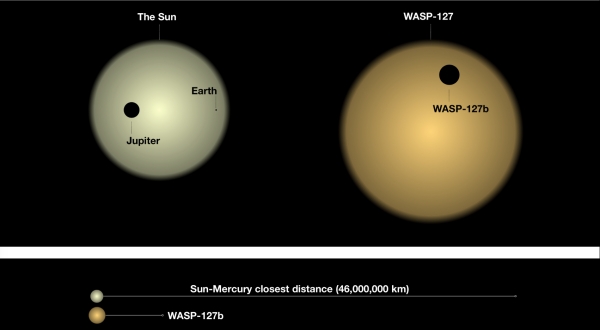
Image: WASP-127b compared with planets of our Solar System. Credits: David Ehrenreich/Université de Genève, Romain Allart/Université de Montréal.
The work on WASP-127b’s atmosphere involves infrared observations from Hubble combined with data from the extraordinary ESPRESSO spectrograph at the European Southern Observatory’s Very Large Telescope in Chile. The method at the VLT is transmission spectroscopy, analyzing the light of the star during a transit as it passes through the planet’s atmosphere. Allart pointed out to the virtual Europlanet Science Congress attendees that surprises were in store:
“First, as found before in this type of planet, we detected the presence of sodium, but at a much lower altitude than we were expecting. Second, there were strong water vapour signals in the infrared but none at all at visible wavelengths. This implies that water-vapour at lower levels is being screened by clouds that are opaque at visible wavelengths but transparent in the infrared. We don’t yet know the composition of the clouds, except that they are not composed of water droplets like on Earth. We are also puzzled about why the sodium is found in an unexpected place on this planet. Future studies will help us understand not only more about the atmospheric structure, but about WASP-127b, which is proving to be a fascinating place.”
The zone within the atmosphere that the scientists were able to probe with their combined datasets proved to be clouds in an atmospheric layer with a pressure ranging between 0.3 and 0.5 millibars. We also know that this is a planet in a retrograde orbit, something Allart says is unexpected for a hot Saturn in a stellar system that is thought to be a whopping 10 billion years old. If things have not settled down by this time (and the planet orbits as well in a different plane than equatorial), it may point to the presence of an unseen planetary companion.
Is planetary migration a possibility here? From the paper:
Our best-fit model shows that the old star WASP-127 is a slow rotator while its planet has a misaligned retrograde orbit (a view of the system is represented in Fig. 4). We also note that the WASP-127 system does not fit in the known dichotomy of hot exoplanets. Winn et al. (2010); Albrecht et al. (2012) have reported that stars with Teff below 6250 K have aligned systems which is not the case of WASP-127b (Teff = 5842 ± 14 K). One possible scenario is that WASP-127b remained trapped in a Kozai resonance with an outer companion for billions of years, and only recently migrated close to its star (see e.g. the case of GJ436b, Bourrier et al. (2018)). An in depth analysis of the system dynamic is beyond the scope of the present study.
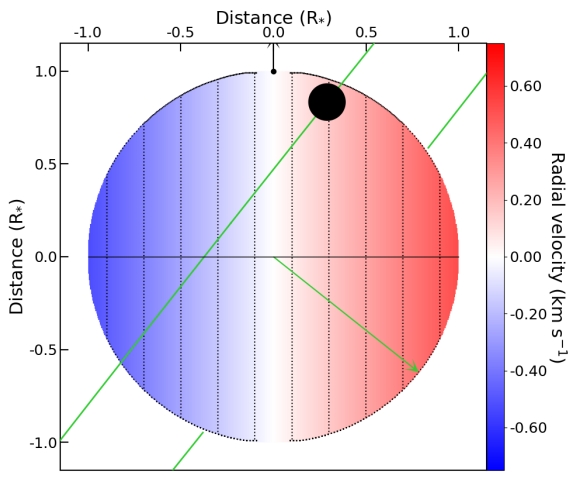
Image: This is Figure 4 from the paper. Caption: Fig. 4: View of the star planet system at the ingress transit. The stellar disk velocity has a color gradient from blue to red for negative to positive stellar surface velocity. The stellar rotation axis is shown as the black top arrow. The planet is represented by the black disk and occults first the red part of the star and then the blue part, following its misaligned orbit shown in green. The green arrow represents the orbital axis. Credit: Allart et al.
So we’ve reached the point where we can tell the difference between cloudy worlds and their cloud-free counterparts by measuring water content, acquiring data that also reveals the pressure of the cloud deck from which the measurements are taken. It’s early days in this kind of analysis, but we can assume that these methods will work their way into future surveys on planetary atmospheres. Understanding atmospheric structure and composition is a path into the formation history and evolution of any exoplanets. Beginning with planets in extreme conditions, we can look forward to future surveys as these techniques are applied to smaller worlds.
The paper is Allart et al., “WASP-127b: a misaligned planet with a partly cloudy atmosphere and tenuous sodium signature seen by ESPRESSO,” Astronomy & Astrophysics Vol. 644 (December, 2020), A155 (abstract / preprint).

Keeping an Eye on Psyche
What makes the asteroid 16 Psyche interesting is that it may well be the exposed core of a planet from the early days of Solar System formation, a nickel-iron conglomeration that normally would lie well below a surface mantle and crust. It’s also an M-class asteroid, a category of which it is the largest known sample. These are mostly made of nickel-iron and thought to be fragmented cores, though many have a composition that has not yet been determined.
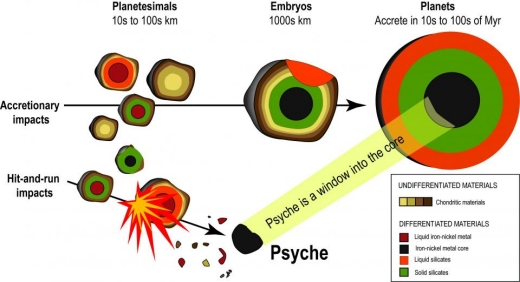
Image: Deep within the terrestrial planets, including Earth, scientists infer the presence of metallic cores, but these lie unreachably far below the planets’ rocky mantles and crusts. Because we cannot see or measure Earth’s core directly, asteroid Psyche offers a unique window into the violent history of collisions and accretion that created the terrestrial planets. Credit: University of Arizona.
M-class asteroids have been imaged before — the Rosetta spacecraft imaged the non-metallic 21 Lutetia in 2010, and 216 Kleopatra has been imaged by ES0’s 3.6 meter telescope at La Silla as well as Arecibo — but now we’ll see one from close orbit.
For Psyche will be visited by a spacecraft of the same name, slated for launch in 2022 via Falcon Heavy, with arrival in 2026 after a 3.5-year cruise under solar electric propulsion. A single Mars flyby will occur along the way. The plan is to spend 21 months in orbit around the asteroid. You’ll recall that this mission will be testing NASA’s DSOC package (Deep Space Optical Communication), using laser techniques to communicate with Earth, See Deep Space Network: A Laser Communications Future for more on the DSOC and its capabilities.
The Psyche spacecraft’s Hall thrusters, using solar arrays as the power source, will be used beyond lunar orbit for the first time in this mission. The propellant is xenon, a neutral gas that will be accelerated and expelled from the spacecraft by electromagnetic fields after being ionized, producing a now familiar blue beam. The spacecraft will carry 922 kilograms of xenon, enough to run the Hall thrusters for years without exhausting available fuel supplies. NASA engineers estimate that chemical methods would require about five times that amount of propellant to achieve the same mission.
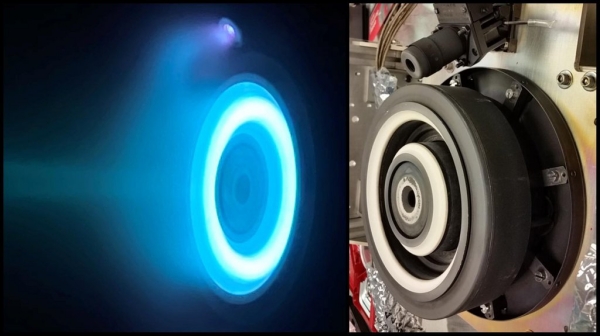
Image: The photo on the left captures an operating electric Hall thruster identical to those that will propel NASA’s Psyche spacecraft, which is set to launch in August 2022 and travel to the main asteroid belt between Mars and Jupiter. The xenon plasma emits a blue glow as the thruster operates. The photo on the right shows a similar non-operating Hall thruster. The photo on the left was taken at NASA’s Jet Propulsion Laboratory in Southern California; the photo on the right was taken at NASA’s Glenn Research Center.
We have fairly scant information about Psyche, as witnessed by the image below, which comes out of an asteroid-imaging project nicknamed HARISSA that is being run by the European Southern Observatory, using adaptive optics on the Very Large Telescope. The survey data along with ground-based radar imaging has determined that Pyche is roughly 226 kilometers wide and contains two interesting surface features, the first of which is a bright area christened Panthia. The second is a huge crater about half the size of the asteroid itself, which the ESO team calls Meroe. No moons have turned up in this work, at least none larger than one kilometer, eliminating one marker for determining the asteroid’s mass.

Image: Views of Psyche from the HARISSA survey, with Meroe and Panthia highlighted. Credit: ESO/LAM.
Orbiting between 378 and 497 million kilometers from the Sun, between the orbits of Mars and Jupiter, Psyche takes five years to complete an orbit, with a rotation period of a little over four hours. If the asteroid is the core of what would have been a planet-sized object, the mission’s science instruments should be able to make the call. They include a multi-spectral imager, a magnetometer, a radio instrument for gravity measurement (tricky at this potato-shaped object) and a gamma-ray and neutron spectrometer. We can hope this will be sufficient to untangle a past likely marked by violent collisions in the era in which the planets were forming.
To keep up with Psyche mission developments from the inside, check the Psyche blog at Arizona State. Here’s a snip from the most recent entry (June 14), from Paige Arthur, who captures some of the excitement of being involved in a deep space mission at building 179, the famed home of JPL’s Spacecraft Assembly Facility:
Engineers and technicians adorned in lab coats, gloves, masks, and hair nets meander around on the floor below, taking measurements with multimeters and mating connectors not too different from the ones Will and I had been handling in the testbed moments before. Along the opposite wall are plaques commemorating all of the spacecraft that have been assembled there — Mariner, Ranger, Voyager, Galileo, Cassini, Curiosity, Opportunity, and, most recently, Perseverance. But in this moment I don’t notice any of it, because my attention is totally captured by the massive spacecraft suspended in the middle.
The Psyche Chassis is a huge black, silver, and gold box the size of a car with an antenna dish fixed to one end. Long struts surround the dish like the spindly legs of a massive aluminum spider, and red electronic boards connected by thick, snaking cords populate the sides. I’ve spent the last two and a half years at JPL working with software simulations and engineering models, with bits of pieces of Psyche’s brain, eyes, and heart, but seeing the physical manifestation of all that work suspended before me in the form of such a tremendous machine still brings me chills.
I’ve never worked on a spacecraft, but I’ve felt the chills, particularly at JPL one day many years ago when I watched Spirit and Opportunity being readied for shipment to Florida. Go Psyche.


